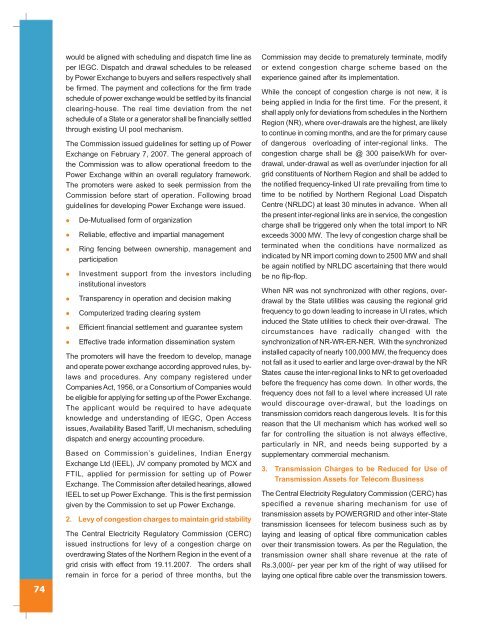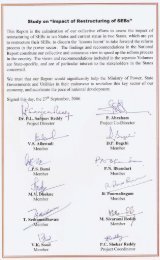MoP - Ministry of Power
MoP - Ministry of Power
MoP - Ministry of Power
You also want an ePaper? Increase the reach of your titles
YUMPU automatically turns print PDFs into web optimized ePapers that Google loves.
74<br />
would be aligned with scheduling and dispatch time line as<br />
per IEGC. Dispatch and drawal schedules to be released<br />
by <strong>Power</strong> Exchange to buyers and sellers respectively shall<br />
be firmed. The payment and collections for the firm trade<br />
schedule <strong>of</strong> power exchange would be settled by its financial<br />
clearing-house. The real time deviation from the net<br />
schedule <strong>of</strong> a State or a generator shall be financially settled<br />
through existing UI pool mechanism.<br />
The Commission issued guidelines for setting up <strong>of</strong> <strong>Power</strong><br />
Exchange on February 7, 2007. The general approach <strong>of</strong><br />
the Commission was to allow operational freedom to the<br />
<strong>Power</strong> Exchange within an overall regulatory framework.<br />
The promoters were asked to seek permission from the<br />
Commission before start <strong>of</strong> operation. Following broad<br />
guidelines for developing <strong>Power</strong> Exchange were issued.<br />
De-Mutualised form <strong>of</strong> organization<br />
Reliable, effective and impartial management<br />
Ring fencing between ownership, management and<br />
participation<br />
Investment support from the investors including<br />
institutional investors<br />
Transparency in operation and decision making<br />
Computerized trading clearing system<br />
Efficient financial settlement and guarantee system<br />
Effective trade information dissemination system<br />
The promoters will have the freedom to develop, manage<br />
and operate power exchange according approved rules, bylaws<br />
and procedures. Any company registered under<br />
Companies Act, 1956, or a Consortium <strong>of</strong> Companies would<br />
be eligible for applying for setting up <strong>of</strong> the <strong>Power</strong> Exchange.<br />
The applicant would be required to have adequate<br />
knowledge and understanding <strong>of</strong> IEGC, Open Access<br />
issues, Availability Based Tariff, UI mechanism, scheduling<br />
dispatch and energy accounting procedure.<br />
Based on Commission’s guidelines, Indian Energy<br />
Exchange Ltd (IEEL), JV company promoted by MCX and<br />
FTIL, applied for permission for setting up <strong>of</strong> <strong>Power</strong><br />
Exchange. The Commission after detailed hearings, allowed<br />
IEEL to set up <strong>Power</strong> Exchange. This is the first permission<br />
given by the Commission to set up <strong>Power</strong> Exchange.<br />
2. Levy <strong>of</strong> congestion charges to maintain grid stability<br />
The Central Electricity Regulatory Commission (CERC)<br />
issued instructions for levy <strong>of</strong> a congestion charge on<br />
overdrawing States <strong>of</strong> the Northern Region in the event <strong>of</strong> a<br />
grid crisis with effect from 19.11.2007. The orders shall<br />
remain in force for a period <strong>of</strong> three months, but the<br />
Commission may decide to prematurely terminate, modify<br />
or extend congestion charge scheme based on the<br />
experience gained after its implementation.<br />
While the concept <strong>of</strong> congestion charge is not new, it is<br />
being applied in India for the first time. For the present, it<br />
shall apply only for deviations from schedules in the Northern<br />
Region (NR), where over-drawals are the highest, are likely<br />
to continue in coming months, and are the for primary cause<br />
<strong>of</strong> dangerous overloading <strong>of</strong> inter-regional links. The<br />
congestion charge shall be @ 300 paise/kWh for overdrawal,<br />
under-drawal as well as over/under injection for all<br />
grid constituents <strong>of</strong> Northern Region and shall be added to<br />
the notified frequency-linked UI rate prevailing from time to<br />
time to be notified by Northern Regional Load Dispatch<br />
Centre (NRLDC) at least 30 minutes in advance. When all<br />
the present inter-regional links are in service, the congestion<br />
charge shall be triggered only when the total import to NR<br />
exceeds 3000 MW. The levy <strong>of</strong> congestion charge shall be<br />
terminated when the conditions have normalized as<br />
indicated by NR import coming down to 2500 MW and shall<br />
be again notified by NRLDC ascertaining that there would<br />
be no flip-flop.<br />
When NR was not synchronized with other regions, overdrawal<br />
by the State utilities was causing the regional grid<br />
frequency to go down leading to increase in UI rates, which<br />
induced the State utilities to check their over-drawal. The<br />
circumstances have radically changed with the<br />
synchronization <strong>of</strong> NR-WR-ER-NER. With the synchronized<br />
installed capacity <strong>of</strong> nearly 100,000 MW, the frequency does<br />
not fall as it used to earlier and large over-drawal by the NR<br />
States cause the inter-regional links to NR to get overloaded<br />
before the frequency has come down. In other words, the<br />
frequency does not fall to a level where increased UI rate<br />
would discourage over-drawal, but the loadings on<br />
transmission corridors reach dangerous levels. It is for this<br />
reason that the UI mechanism which has worked well so<br />
far for controlling the situation is not always effective,<br />
particularly in NR, and needs being supported by a<br />
supplementary commercial mechanism.<br />
3. Transmission Charges to be Reduced for Use <strong>of</strong><br />
Transmission Assets for Telecom Business<br />
The Central Electricity Regulatory Commission (CERC) has<br />
specified a revenue sharing mechanism for use <strong>of</strong><br />
transmission assets by POWERGRID and other inter-State<br />
transmission licensees for telecom business such as by<br />
laying and leasing <strong>of</strong> optical fibre communication cables<br />
over their transmission towers. As per the Regulation, the<br />
transmission owner shall share revenue at the rate <strong>of</strong><br />
Rs.3,000/- per year per km <strong>of</strong> the right <strong>of</strong> way utilised for<br />
laying one optical fibre cable over the transmission towers.

















